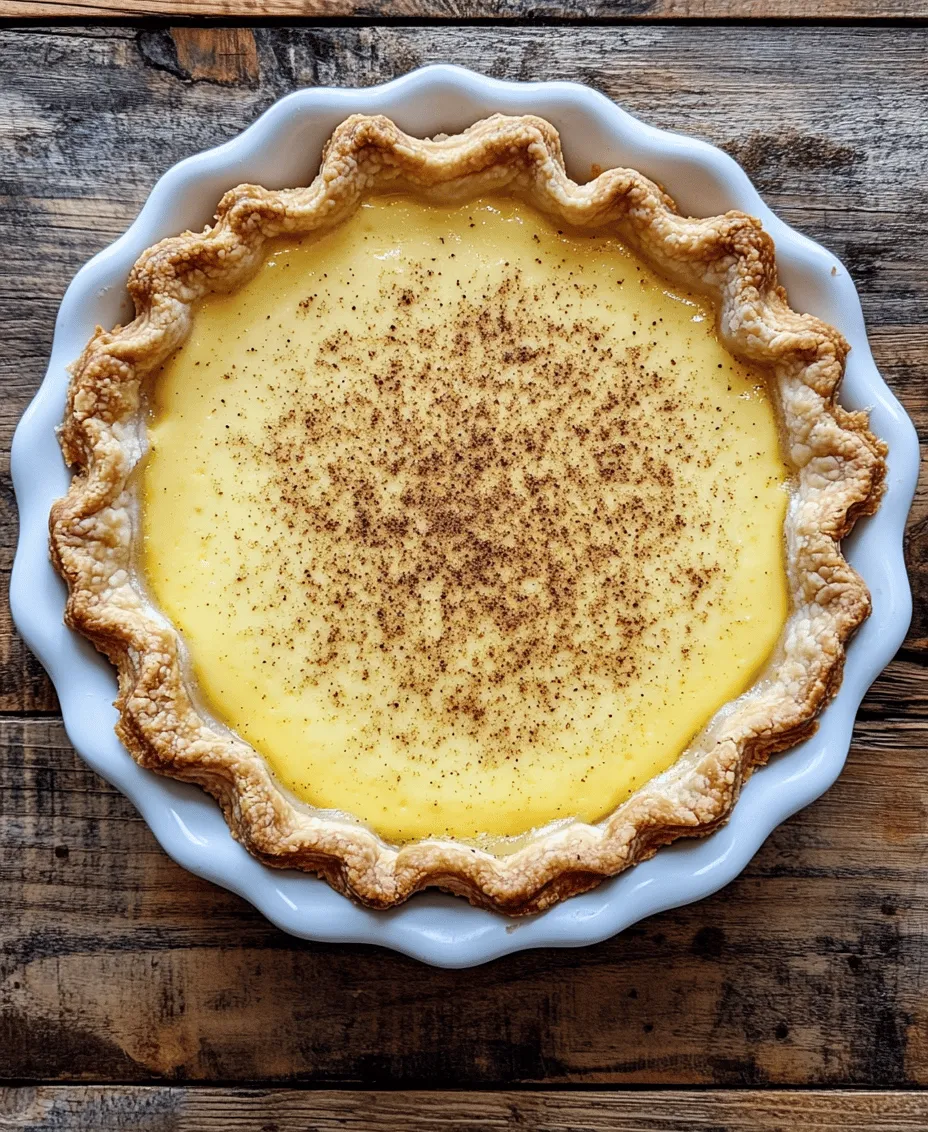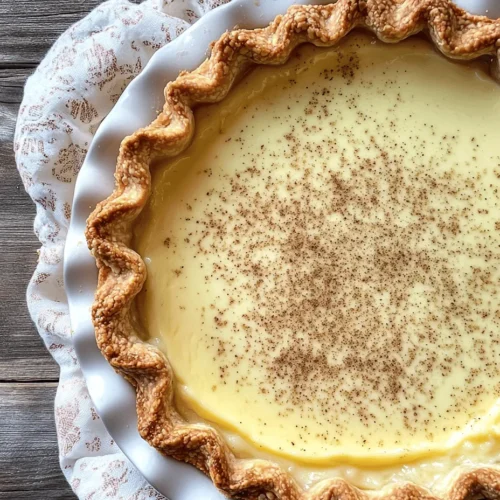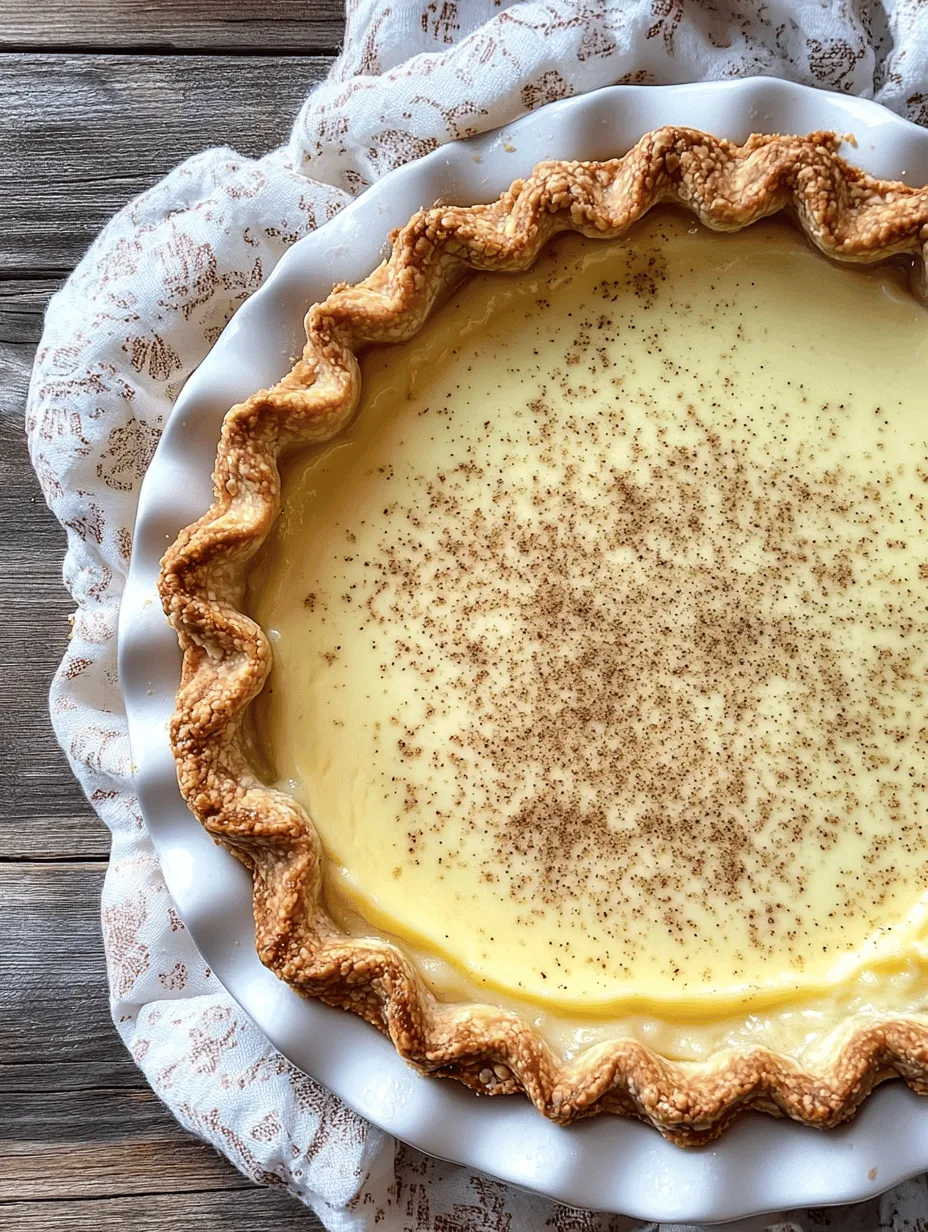Introduction to Classic Old-Fashioned Egg Custard Pie
In the realm of classic desserts, few can rival the comforting allure of an old-fashioned egg custard pie. This delightful treat, with its creamy filling cradled in a perfectly baked crust, evokes a sense of nostalgia that transports many of us back to cherished family gatherings and home-cooked meals. The simplicity of the ingredients, combined with the richness of the custard, makes this pie an accessible and beloved recipe for bakers of all skill levels.
Historically, egg custard pie has roots deeply embedded in American cuisine. Its origins can be traced back to early colonial times when settlers sought to bring a taste of home to their new surroundings. This pie has been a staple in many kitchens, often associated with warmth and comfort. Whether served at a holiday feast or enjoyed as an everyday dessert, the egg custard pie symbolizes the heart of home cooking—simple, wholesome, and utterly satisfying.
The beauty of egg custard pie lies not just in its taste but also in its adaptability. With a few simple ingredients that are often found in your pantry, you can create a dessert that is both elegant and heartwarming. It’s a recipe that invites creativity while honoring tradition, making it a perfect choice for any occasion.
Understanding the Ingredients
To create the perfect classic egg custard pie, it’s essential to understand the role of each ingredient. This pie is defined by its smooth, creamy filling and flaky crust, both of which contribute to its signature taste and texture.
The Pie Crust
The success of any pie begins with a great crust. For the classic egg custard pie, a flaky, tender pie crust is crucial. You have two main options: homemade or store-bought.
Homemade Pie Crust: Making your own pie crust may seem intimidating, but it can be quite simple with the right technique. A homemade crust allows you to control the ingredients, resulting in a fresher and more flavorful base. The key is to use cold butter and ice water, which help create that coveted flaky texture.
Store-Bought Pie Crust: If you’re short on time or prefer convenience, a store-bought crust can be a great alternative. Look for high-quality options that use minimal preservatives for the best flavor. Just be sure to follow the package instructions for pre-baking if required.
Regardless of your choice, the crust should be blind-baked before adding the custard filling to ensure it remains crisp and doesn’t become soggy during baking.
Eggs
At the heart of the custard filling are eggs, which serve as the foundation of this dessert. Eggs provide structure and richness, creating that signature creamy texture we all love. When whisked together, the proteins in the eggs coagulate during baking, setting the filling while still allowing it to remain soft and smooth.
Using fresh, high-quality eggs will enhance the overall flavor of the pie. If you can, opt for farm-fresh eggs, as they tend to have a richer flavor and vibrant yolks, which contribute to the custard’s beautiful color.
Sugar
Granulated sugar plays a crucial role in balancing flavors and enhancing sweetness in the egg custard pie. It not only sweetens the custard but also helps in achieving a smooth texture by dissolving during the mixing process.
For a hint of complexity, you can experiment with different types of sugar. Brown sugar, for instance, can add a subtle caramel flavor, while coconut sugar offers a unique taste profile. However, for a classic egg custard pie, standard granulated sugar remains the preferred choice.
Whole Milk
Whole milk is the secret ingredient that enriches the custard, giving it a creamy texture and a luxurious mouthfeel. The fat content in whole milk ensures that the custard is not only smooth but also satisfying.
While some recipes may call for half-and-half or heavy cream, using whole milk strikes a perfect balance between creaminess and lightness, making it an ideal choice for this pie. If you’re looking for a lighter alternative, you can substitute with low-fat milk, but be aware that it may alter the richness of the final product.
Vanilla Extract
No egg custard pie is complete without the warm, inviting flavor of vanilla extract. This ingredient enhances the overall flavor profile, adding depth and aroma that pairs beautifully with the creamy custard.
For the best results, use pure vanilla extract instead of imitation vanilla, as the latter can have a synthetic taste that detracts from the pie’s quality. If you’re feeling adventurous, consider infusing the milk with a vanilla bean for an even more intense flavor.
Nutmeg
Nutmeg is a quintessential spice in custard recipes, lending its aromatic qualities and warm notes to the pie. Traditionally, nutmeg is sprinkled on top of the custard before baking, creating an enticing aroma as it bakes.
When using nutmeg, it’s best to opt for freshly grated over pre-ground, as it provides a more robust flavor. A little goes a long way, so start with a small amount and adjust according to your taste preferences.
Salt and Butter
A pinch of salt is essential in balancing the sweetness of the custard, enhancing the overall flavor without making it taste salty. It helps to highlight the other flavors in the pie, creating a well-rounded dessert.
Melted butter is another key ingredient that adds richness and flavor depth to the custard filling. It contributes to the smooth texture, making each bite indulgent. Be sure to use unsalted butter to maintain control over the saltiness of the pie.
Step-by-Step Guide to Making Egg Custard Pie
Now that we understand the importance of each ingredient, let’s dive into the step-by-step process of making a classic old-fashioned egg custard pie. This guide will take you through everything from preheating your oven to mixing the custard filling.
Preheating the Oven
Before you begin preparing the pie, it’s vital to preheat your oven to ensure even baking. Set the temperature to 350°F (175°C). Preheating allows the custard to cook evenly, resulting in a smooth, creamy filling with the perfect texture.
Preparing the Pie Crust
If you’re making a homemade pie crust, start by rolling out your dough on a lightly floured surface. Aim for a thickness of about 1/8 inch. Carefully fit the rolled-out dough into a 9-inch pie pan, pressing it gently into the corners and trimming any excess dough hanging over the edges.
Tips for Avoiding Common Mistakes:
– Avoid Stretching the Dough: When fitting the crust, be careful not to stretch it, as this can cause it to shrink during baking.
– Chill the Crust: If you notice that the dough is soft, chill it in the refrigerator for about 15 minutes before baking. This helps maintain its shape while baking.
Once the crust is fitted, prick the bottom with a fork to prevent bubbling. If the recipe requires blind baking, cover the crust with parchment paper and fill it with pie weights or dried beans, then bake for about 10-15 minutes until lightly golden. Remove the weights and parchment paper, and allow the crust to cool.
Mixing the Custard Filling
In a large mixing bowl, start by whisking together the eggs. It’s important to whisk them thoroughly until they are well combined and slightly frothy. This aeration will contribute to a light texture in the finished custard.
Next, gradually add the granulated sugar to the eggs, whisking continuously to ensure that the sugar dissolves completely. This step is crucial for achieving a smooth custard without any graininess.
Incorporating Milk and Flavorings
Once the sugar is fully incorporated, it’s time to add the whole milk and the pure vanilla extract. Pour the milk in a slow, steady stream while whisking to maintain a uniform consistency in the mixture.
Incorporating the milk at this stage provides the custard with its creamy texture. It’s essential to blend the mixture well so that all the ingredients are evenly distributed.
Adding Butter
Finally, melt the unsalted butter and allow it to cool slightly before adding it to the custard mixture. Pour the melted butter in while whisking to ensure it combines seamlessly with the rest of the ingredients. This addition will deepen the custard’s richness and enhance the overall flavor of the pie.
With all the components prepared and combined, you are now ready to pour the custard filling into the prepared pie crust. The next steps will involve baking the pie and waiting for the magic to happen as it transforms into a delectable dessert.
Stay tuned for the continuation of this recipe, where we will guide you through the baking process and share tips for achieving the perfect egg custard pie.

Filling the Pie Crust
Once your pie crust is prepped and cooled, it’s time to fill it with the luscious egg custard mixture. Pouring the custard into the crust is a delicate process, but with a few tips, you can avoid creating a mess and ensure a beautiful pie presentation.
Begin by placing the pie crust on a sturdy baking sheet. This will not only make it easier to transfer the pie to and from the oven but will also catch any spills that may occur during the pouring process. Using a ladle or a measuring cup with a spout can help control the flow of the custard as you pour it into the crust. Start by pouring a small amount of custard into the center of the pie crust, allowing it to spread naturally to the edges. This method reduces the risk of the filling sloshing over the sides.
As you pour, keep an eye out for any air bubbles that may form in the custard. If you notice bubbles, you can gently tap the pie crust on the countertop or give the pie a slight jiggle to encourage them to rise to the surface. If desired, you can also run a skewer or toothpick through the custard gently to help release trapped air. Once filled, carefully transfer the pie to the preheated oven, and let the baking magic begin.
Baking the Pie
Baking the egg custard pie requires a bit of attention to achieve the perfect texture. Preheat your oven to 350°F (175°C) before you begin filling the pie. Once the pie is in the oven, you’ll want to bake it for about 35 to 45 minutes. However, baking times may vary based on your oven and the depth of your pie.
To determine if your pie is perfectly baked, look for a few key visual and textural cues. The edges of the custard should be set, while the center will still have a slight jiggle. If the center is completely firm, it may have overcooked and could result in a less creamy texture. A toothpick inserted into the edge of the pie should come out clean, while a toothpick inserted into the center might have a few moist bits clinging to it. This is a good sign that the custard will set further as it cools.
Additionally, you can check for a light golden hue on the surface of the custard. If the top begins to brown too much during baking, you can cover it loosely with aluminum foil to prevent burning. Once you’ve achieved the right consistency and color, remove the pie from the oven and allow it to cool on a wire rack.
Cooling and Serving
After baking, it’s important to cool your egg custard pie properly before serving. Cooling allows the custard to firm up further, ensuring that it slices beautifully. Let the pie sit at room temperature for about 30 minutes before transferring it to the refrigerator. Chilling the pie for at least a couple of hours (or even overnight) will enhance the flavors and provide a firmer texture.
When it comes to serving, slice the pie into wedges and serve it chilled. You may wish to add a dollop of whipped cream on top for an extra indulgent touch or garnish with a sprinkle of nutmeg or cinnamon for added flavor. Fresh fruits, like berries or sliced peaches, can also complement the creamy custard beautifully.
The Science Behind Custard
Understanding the science behind custard can elevate your pie-making skills. At its core, custard is a delicate balance of eggs and milk, which work together to create a stable, creamy filling.
Emulsification
The process begins with emulsification, where the fat in the milk and the proteins in the eggs blend to create a smooth mixture. The proteins in the egg yolks play a crucial role in thickening the custard. As the pie bakes, the heat causes the proteins to unfold and bond with one another and the milk proteins, creating a stable structure that holds the custard together.
Setting the Custard
Heat is essential for coagulating the proteins in the eggs. As the custard cooks, the proteins transform from a liquid state to a gel-like consistency, leading to a set custard. It’s important to cook the custard slowly and evenly to avoid curdling, which occurs when eggs are exposed to excessive heat. This is why a water bath can be beneficial when baking custard pies, as it helps maintain a gentle cooking temperature.
Texture and Consistency
The ideal egg custard pie strikes a balance between creaminess and firmness. A well-made custard should be smooth and silky, without any graininess. The texture should be rich, yet not overly dense. The key is to monitor your baking time and ensure that the custard is set but still retains a slight jiggle in the center for that perfect mouthfeel.
Variations and Adaptations
One of the joys of making egg custard pie is its versatility. While the classic recipe is beloved, there are many ways to customize it to suit various tastes and dietary preferences.
Flavor Variations
For those looking to experiment, consider incorporating different flavors into your custard. Chocolate lovers can add melted dark chocolate to the custard mixture for a rich chocolate custard pie. For a tropical twist, try mixing in shredded coconut and a hint of vanilla. Lemon-infused custard can be achieved by adding fresh lemon juice and zest, creating a refreshing citrus flavor that contrasts beautifully with the creaminess of the custard.
Crust Options
If you have dietary restrictions or preferences, there are several crust alternatives you can explore. Gluten-free options are widely available, including almond flour or coconut flour crusts that can provide a delightful crunch. For a healthier twist, consider using a crust made from oats or nuts. These options not only cater to dietary needs but can also add an exciting new flavor to the pie.
Serving Suggestions
To enhance your egg custard pie experience, consider pairing it with complementary toppings or sides. A dollop of freshly whipped cream adds a lightness that balances the richness of the custard. Fresh fruit, like berries or sliced citrus, can provide a refreshing contrast. For an indulgent treat, drizzle a bit of caramel or chocolate sauce over the pie just before serving.
Cultural Significance and History of Egg Custard Pie
Egg custard pie holds a special place in American culinary history, reflecting a rich tradition that spans generations.
Historical Context
The origins of egg custard pie can be traced back to early American settlers who brought their cooking traditions with them from Europe. It quickly became a staple in American households, celebrated for its simplicity and comforting flavors. As an affordable dessert, it was often made during family gatherings and special occasions, solidifying its status as a beloved classic.
Regional Variations
Over time, different regions began to put their own spin on the classic recipe. In the Southern United States, for instance, egg custard pie might be flavored with additional spices like cinnamon or nutmeg and served with a rich buttery crust. In contrast, Northern variations may lean towards a more straightforward custard with a hint of vanilla. These regional adaptations showcase the pie’s flexibility and the creative spirit of home cooks across the country.
Conclusion: The Timeless Appeal of Egg Custard Pie
Egg custard pie is more than just a dessert; it’s a nostalgic reminder of home and family gatherings. Its simplicity, combined with its rich and creamy texture, ensures that it remains a favorite among dessert lovers. As you embark on making this classic recipe, remember that it is not just about the final product but the experiences and memories created in the kitchen.
Whether you choose to stick with the traditional flavors or experiment with your own variations, egg custard pie embodies the spirit of comfort food. As it graces your table, it invites conversations, laughter, and shared moments that transcend generations. Embrace the timeless appeal of egg custard pie, and let it become a cherished part of your culinary repertoire.



